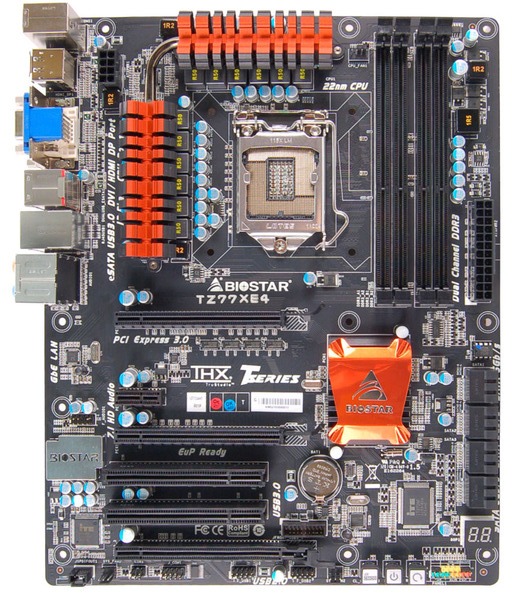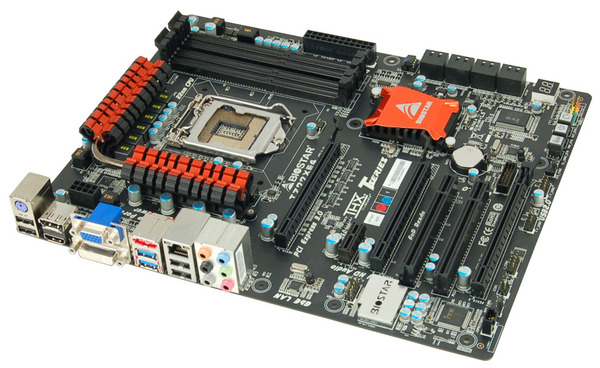Intel Z77 Panther Point Chipset and Motherboard Preview – ASRock, ASUS, Gigabyte, MSI, ECS and Biostar
by Ian Cutress on April 8, 2012 12:00 AM EST- Posted in
- Motherboards
- Intel
- Biostar
- MSI
- Gigabyte
- ASRock
- Asus
- Ivy Bridge
- ECS
- Z77
Biostar TZ77XE4—Visual Inspection
With memories of Biostar fresh in my mind from the 990FX roundup, I have another chance to tackle a motherboard from them. This one comes in at more of a premium than the other—at an MSRP of $169 it is not the cheapest board this time. However, it does seem to have learned some lessons with the PCIe layout at least, but in terms of features we are perhaps a bit lacking.
Biostar have characteristically been black and orange, and we see it here again on their top Z77 model, the TZ77XE4. Power delivery is essentially a 10+2 (CPU/iGPU) system with large brightly colored heatsinks to remove heat, both connected via a heatpipe. These heatsinks are set a little away from the Intel designated socket area, though the memory banks are right up against the boundary—with only two sticks of memory in the board there will be enough room for most of the beefiest air coolers.
In terms of fan headers, Biostar have unfortunately put much effort in here, with only three to play with—a 4-pin CPU fan header to the top right of the socket, and two 3-pin at the south end of the board. Anyone requiring headers for fans will have to resort to providing their own fan control.

Along the right hand side, apart from the 24-pin power connector, we have a series of eight SATA ports—two SATA 6 Gbps from the PCH, four SATA 3 Gbps also from the PCH, and another two SATA 6 Gbps from an ASMedia controller. These are unfortunately not color coded, meaning users will have to double check every time that the SATA cable is going into the port as intended. Below these, we have a two-digit debug display for error reporting.
The chipset heatsink sports the bright orange Biostar color, but is rather small which could lead to it being warm to the touch. On the south side of the board, we are not exactly bursting with headers—aside from the fans, we have front panel headers, a pair of USB 2.0 headers, and power/reset/clear CMOS buttons. These buttons are all similar and next to each other, so I can just see myself accidentally pressing the wrong one from time to time. It is also important to note the location of a USB 3.0 header, just above the third full-length PCIe slot. This is a rather awkward place, and cements its use primarily for rear facing adaptors (as long as there is nothing in the PCI slot beside it).

The PCIe layout is better than previous iterations, featuring an x16 (x8 in dual-GPU), x1, x8, PCI, PCI and Gen 2.0 x4. This leaves a space between GPUs, and a spare x1, PCI and x4 when dual GPUs are being used. Note we do not have a molex connector here, suggesting that Biostar are happy with the power delivery when the PCIe slots are in use.

For back panel functionality, we have a PS2 keyboard port, two USB 2.0 ports (black), DisplayPort, HDMI, D-Sub, DVI-I, eSATA, two USB 3.0 (blue), gigabit Ethernet, two more USB 2.0 (black), and audio jacks. I should stress that even though there is a DVI-I on the back panel, it does not accept analog signals by adaptor.
Board Features
| Biostar TZ77XE4 | |
| Size | ATX |
| CPU Interface | LGA-1155 |
| Chipset | Intel Z77 |
| Power Delivery | 10 + 2 + 1 + 2 (CPU/GPU/VCCIO/Memory) |
| Memory Slots |
Four DDR3 DIMM slots supporting up to 32 GB Up to Dual Channel, 1066-2600 MHz |
| Video Outputs | DisplayPort, HDMI, DVI-D, D-Sub |
| Onboard LAN | Realtek 8111E |
| Onboard Audio | Realtek ALC898 |
| Expansion Slots |
2 x PCIe x16 Gen3 (x16, x8/8) 1 x PCIe x16 Gen2 (x4) 1 x PCIe x1 Gen2 2 x PCI |
| Onboard SATA/RAID |
2 x SATA 6 Gbps (PCH), Support for RAID 0, 1, 5, 10 4 x SATA 3 Gbps (PCH), Support for RAID 0, 1, 5, 10 2 x SATA 6 Gbps (ASMedia Controller) 1 x eSATA 3 Gbps |
| USB |
4 USB 3.0 ports (2 back panel, 2 from headers) 8 USB 2.0 ports (4 back panel, 4 from headers) |
| Onboard |
4 x SATA 6 Gbps 4 x SATA 3 Gbps 1 x USB 3.0 Header 2 x USB 2.0 Header 3 x Fan Headers 1 x CIR Header 1 x SPDIF Output Header 1 x Front Panel Audio Header |
| Power Connectors |
1 x 24-pin ATX connector 1 x 8-pin 12V connector |
| Fan Headers |
1 x CPU Fan Header (4-pin) 2 x SYS Fan Header (3-pin) |
| IO Panel |
1 x PS/2 Keyboard Port 1 x eSATA 2 x USB 3.0 4 x USB 2.0 1 x DisplayPort 1 x HDMI 1 x DVI-D 1 x D-Sub 1 x Gigabit Ethernet Audio Jacks |
| Warranty Period | 3 years from date of sale |
| Product Page | Link |
Aside from the extra SATA controller, PCI slots, Power/Reset buttons and the use of all four display outputs, there's nothing much 'extra' that Biostar have put on the board which isn't already in the default chipset. This could perhaps be their downfall when it comes to conclusions after testing.










145 Comments
View All Comments
mechjman - Monday, April 9, 2012 - link
I don't remember seeing PCIe 3.0 support straight from P6x series chipsets.http://www.intel.com/content/www/us/en/chipsets/ma...
If this is regarding in use with a PLX chip, it might be good to state so.
extide - Tuesday, April 10, 2012 - link
It's actually when the boards DONT use a plx chip, or if the use 3.0 capable ones. It's only the boards that use 2.0 chips that are limited to 2.0GameLifter - Tuesday, April 10, 2012 - link
I am very curious to see how this technology will affect the overall performance of the RAM. If it works well, I may have to get the P8Z77-V Pro.jbuiltman - Tuesday, April 10, 2012 - link
I am leaving my AMD FX-60, 3 GB DDR, Asus 939 Delux, Win XP, Raptor 150 HDD for IVY Bridge pasures!!!I am all for ASUS 16+4 power, multi usb 2.0 and 3.0 on the back panel. I also like the multiple 4 pin fan plug ins, mem ok, LED problem indicator, switches, 4 SATA 6GB connectors and heat pipes connecting the alunimum fins.
What i want to see is 16x/16x not 8x/8x on dual video card on a Z77 board. ASUS, don't skimp for a measly $30! I hate cheap companies and don't make me think you are just being cheap!!!
jbuiltman - Tuesday, April 10, 2012 - link
Hey all you MoBo companies. Don't get cheap with the Z77 boards and not include 16x/16x on the pci-e 3.0!!!! Come on, add what you need to and pass the $30 on to me!!!!ratbert1 - Wednesday, April 11, 2012 - link
"ASUS as a direct standard are now placing Intel NICs on all their channel motherboards. This is a result of a significant number of their user base requesting them over the Realtek solutions."Um... ASUS P8Z77-V LX has Realtek!
and...ASUS P8H77-M PRO has Realtek!
There are more.
ratbert1 - Wednesday, April 11, 2012 - link
I meant P8Z77-M PRO, but the H77 has it as well.lbeyak - Sunday, April 15, 2012 - link
I would love a detailed review of the Gigabyte G1.Sniper 3 Z77 board when it becomes available.Keep up the good work!
csrikant - Sunday, April 22, 2012 - link
Dual E5-2690So far best i have got burn a lot $$$ to get this right
my last build was with I7 990x got itchy in oct 2011 with some minor issue decided to change my PC got my i7 2700K did not meet my expectation
built i7 3960x still failed many of my requirements regret my pc change from 990x
Finally with all my pain and wasting$$ got my new build that so far perform better than my 990X build
My advice do not get carried away by fancy new i7 release they are just little benefit for P4 just wasting time I was shocked that they released P4 with 1155 socket it was having same performace as 2700K not much change in fact it was cheaper too.
Am not expert an average system builder but my advice from bottom of my heart is just go for E5 build if you are really looking for performace and some benefits you may spend some extra $$ on MB ,CPU,Casing etc it is worth in long run works out cheper than any fancy High end gaming rig water cooling etc all just shit tech advice. Never get ferrari performance form mod toyota.
mudy - Monday, April 23, 2012 - link
With the third pcie lane on the z77 boards I have come across almost all manufacturers saying "1xPCI Express 2.0 x16 (x4 Mode) & only available if a Gen 3 CPU are used". Does this mean that the lane is pcie 2.0 at x16 but works at pcie 3.0 x4 mode, if an IVB processor is connected, and other two pcie 3.0 lane is populated giving x8/x4x4 speed with pcie 3.0 compliant cards?? Also what will happen if I put Pcie 2.0 GPUs in the first two pcie 3.0 x16 slots and a pcie 2.0 compliant raid card (rr2720SGL) in the third pcie lane? Will it give me an effective pcie 2.0 bandwidth of x16/x8/x8 or not?? Damn these are so confusing!! I wish anandtech would do an extensive review on just the pcie lanes covering all sorts of scenario and I think NOW would be the best time to this as the transition from pcie 2.0 to pcie 3.0 will happen slowly (maybe years) so majority end-user will still be keeping their pcie 2.0 compliant devices!!Thanks